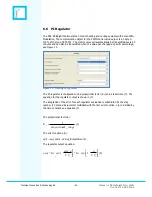
function Innovation & Technology AS
- 11 -
Manual – KNX MultiLight Art.nr 44001
Doc.no. D-TS-ML-K-005-A
5.2
LUX sensor
5.2.1
Parameters
The lux sensor has two communication objects, one for the LUX value (Current Value)
and a threshold switch (Lux threshold switch). The object, “Lux threshold switch", will be
high or low based on the LUX value and the parameters below.
Figure 6 - Lux sensor parameter window
1.
High threshold value:
If the Lux value goes above this value the "Lux threshold
switch" will be set low or no action (depending on the parameter “Action above high
threshold value”).
2.
Hystereses for lower value: “
High threshold value” – “hysteresis for lower value”
will give the lower limit for the ”Lux threshold switch”. If the current lux value is
below this value, the Lux threshold switch is set high or no action (depending on the
parameter “Action below low threshold value”)
3.
Time delay
can be specified both for turning on and off the lux threshold switch.
The time delay can be between 1 and 255 seconds. The value “0” will disable the
time delay.
4.
Cyclic sending
of the lux threshold switch can be activated with a cycle time
between 1 and 255 minutes.
5.2.2
LUX calibration
The lux level object, “Lux Sensor: Current value (lux)”, can be calibrated by writing to
the object. The raw lux value will be subtracted from the written value and stored
permanently in EEPROM/flash.
Both raw values and the resulting calibrated values are shown in Figure 7. The pink line
is the raw value (V) from the sensor, the blue line is the wanted value (W) set by the
user. The calibration factor is: C=1-(V-W/V)
If the raw value V=1000, and the object is updated with 800, then the calibration factor
will be: c=1-(1000-800)/1000=0.8. See the graph in Figure 7.
The formula for calculating the lux is: Lux=c*V












































